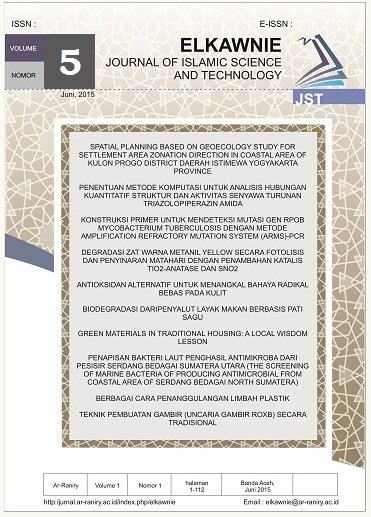Green Synthesis of Reduced Graphene Oxide Using Lime Juice Reductor From Citrus aurantifolia
DOI:
https://doi.org/10.22373/ekw.v5i2.4948Keywords:
citric acid, Citrus aurantifolia, green synthesis, reduced graphene oxide (rGO)Abstract
In this study, the reduced graphene oxide (rGO) synthesized by using lime juice as an environmentally friendly reducing agent and inexpensive cost. The synthesis was carried out by oxidizing graphite with the Hummer method to form graphene oxide (GO) was formed, then the GO was reduced by using lime as the natural reducing agent. X-ray analysis shown a vital diffraction pattern for graphite at 2θ = 26.4°, for graphene oxide appears around 2θ = 10° and 43o, and rGO at 2θ = 23.8°. Furthermore, the infrared spectrum of the three samples showed the peak of the hydroxyl group at 3412 cm-1, which appeared on graphene oxide, but was not observed in rGO. The vibrational mode of carbonyl (C=O) at 1723 cm-1 was also observed with high intensity on graphene oxide. This information showed that GO has a large number of oxygen-containing groups. Then, in the dissolution test shown that the GO was more soluble in polar solvents such as water than ethanol.References
Agharkar, M., Kochrekar, S., Hidouri, S., & Azeez, M. A. (2014). Trends in green reduction of graphene oxides, issues and challenges: A review, Materials Research Bulletin, 59, 323-328.
Ferrero, F., Cinzia, T., & Periolatto, M. (2014). Adsorption of chromatecupric
ions onto chitosan-coated cotton gauze, Carbohydr Polym, 110, 367–73.
Jingjing, W., Liang, D., Jun, W., & Liu, F. (2014). Adsorption of copper ions
by ion-imprinted simultaneous interpenetrating network hydrogel: thermodynamics, morphology and mechanism, Appl Surf Sci, 305, 412–18.
Kyzas, G. Z., Deliyanni, E. A., & Mitropoulos, A. C. (2018). Graphene composites as dye adsorbents: Review, Chem Eng Res Des, 129, 75-88.
Liu, J., Liu, W., Xu, M., & Wang, B. (2016). A novel reusable nanocomposite adsorbent, xanthated Fe3O4-chitosan grafted onto graphene oxide, for removing Cu(II) from aqueous solutions, Appl. Surf. Sci, 367, 2016, 327-334.
Lopez, M. P. L., Carrero, A. P., Silva, L. S., Valverde, J. L., & Romero, A. (2017). Influence of the reduction strategy in the synthesis of reduced graphene oxide, Adv. Powder Technol, 28(12), 3195-3203.
Penniston, K. L., Nakada, S. Y., Holmes, R. P., & Assimos, D. G. (2008). Quantitative Assessment of Citric Acid in Lemon Juice, Lime Juice, and Commercially-Available Fruit Juice Products, J Endourol. 22(3), 567–570.
Silva, K. K. H. D., Huang, H. H., & Yoshimura, M. (2018). Progress of reduction of graphene oxide by ascorbic acid, Appl. Surf. Sci, 447, 338-346.
Tingshun, J., Wangping, L., Mao, Y., Zhao, H., Liming, D., Zhang, S., & Zhao, Q. (2015). Adsorption behavior of copper ions from aqueous solution onto graphene oxide CdS composite. Chem Eng J, 259, 603–10.
Zhang, H., Yu, X., Guo, D., Qu, B., Zhang, M., Li, Q., & Wang, T. (2013). Synthesis of bacteria promoted reduced graphene oxide–nickel sulfide networks for advanced supercapacitors, ACS Appl. Mater. Interf, 5, 7335–7340.
Downloads
Published
Issue
Section
License
Proposed Policy for Journals That Offer Open Access Authors who publish with the Elkawnie journal agree to the following terms:
a. Authors retain copyright and grant the journal right of first publication with the work simultaneously licensed under a Creative Commons Attribution License that allows others to share the work with an acknowledgement of the work's authorship and initial publication in this journal.
b. Authors are able to enter into separate, additional contractual arrangements for the non-exclusive distribution of the journal's published version of the work (e.g., post it to an institutional repository or publish it in a book), with an acknowledgement of its initial publication in this journal.
c. Authors are permitted and encouraged to post their work online (e.g., in institutional repositories or on their website) prior to and during the submission process, as it can lead to productive exchanges, as well as earlier and greater citation of published work (see The Effect of Open Access).

























